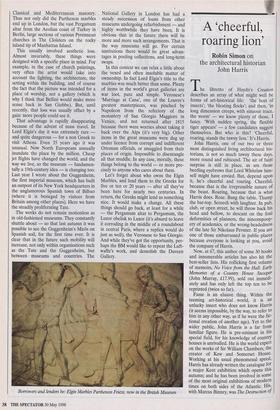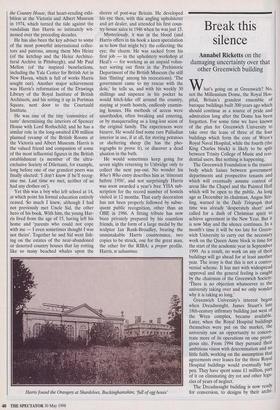A 'cheerful, roaring lion'
Robin Simon on the architectural historian John Harris The libretto of Haydn's Creation describes an array of what might well be forms of art-historical life: 'the host of insects'; 'the bleating flocks'; and then, 'in long dimension creeps, with sinuous trace, the worm' — we know plenty of those, I fancy. 'With sudden spring, the flexible tiger appears' — a few candidates suggest themselves. But who is this? 'Cheerful, roaring, stands the tawny lion.' It's Harris.
John Harris, one of our two or three most distinguished living architectural his- torians, is not so much tawny these days, more round and rubicund. The air of faint surprise is still in place, as are those beetling eyebrows that Lord Whitelaw him- self might have envied. But, depend upon it, he's cheerful and roaring. Cheerful, because that is the irrepressible nature of the beast. Roaring, because that is what Harris does. Roar. Bang the table. Thump the bar-top. Screech with laughter. In pub, club, or open street, he will throw back his head and bellow, to descant on the foul deformities of planners, the nincompoop- ery of academics, or the wrong-headedness of the late Sir Nikolaus Pevsner. If you are one of those embarrassed in public places because everyone is looking at you, avoid the company of Harris. Now, at 67, this author of some 30 books and innumerable articles has also hit the best-seller lists. His rollicking first volume of memoirs, No Voice from the Hall: Early Memories of a Country House Snooper (John Murray, £17.99), sold out immedi- ately and has only left the top ten to be reprinted (twice so far). Fame is an elusive thing. Within the teeming art-historical world, it is all unlucky insect who does not know Harris (it seems impossible, by the way, to refer to him in any other way, as if he were the fic- tional creation of another age). Yet to the wider public, John Harris is a far from familiar figure. He is pre-eminent in his special field, for his knowledge of country houses is unrivalled. He is the world expert on the works of Sir William Chambers, the creator of Kew and Somerset House. Working at his usual phenomenal speed, Harris has already written the catalogue for a major Kent exhibition which opens this autumn; and he has been involved in some of the most original exhibitions of modern times on both sides of the Atlantic. His, with Marcus Blarney, was The Destruction of the Country House, that heart-rending exhi- bition at the Victoria and Albert Museum in 1974, which turned the tide against the vandalism that Harris so intimately wit- nessed over the preceding decades.
He has also been the key adviser to some of the most powerful international collec- tors and patrons, among them Mrs Heinz (of the ketchup and the Heinz Architec- tural Archive in Pittsburgh), and Mr Paul Mellon (of the inspired benefactions, including the Yale Center for British Art in New Haven, which is full of works Harris sought out). Another major achievement was Harris's reformation of the Drawings Library of the Royal Institute of British Architects, and his setting it up in Portman Square, next door to the Courtauld Institute.
He was one of the tiny 'committee of taste' determining the interiors of Spencer House with Lord Rothschild; and he has a similar role in the long-awaited £30 million planned revamp of the British Rooms at the Victoria and Albert Museum. Harris is the valued friend and companion of some of the most influential figures in the British establishment (a member of the ultra- exclusive Society of Dilettanti, for example, long before one of our grandest peers was finally elected: 'I don't know if he'll recog- nise me. Last time we met, neither of us had any clothes on').
Yet this was a boy who left school at 14, at which point his formal education entirely ceased. So much I knew, although I had not previously met Uncle Sid, the other hero of his book. With him, the young Har- ris lived from the age of 15, having left his home and 'parents who could not cope with me — I even sometimes thought I was not theirs'. Together he and Sid went fish- ing on the estates of the near-abandoned or deserted country houses that lay rotting like so many beached whales upon the shores of post-war Britain. He developed his eye then, with this angling upholsterer and art dealer, and attended his first coun- try-house sales in 1946 when he was just 15.
Mysteriously, it was in the blood (and Harris offers in his book a keen speculation as to how that might be): the collecting; the eye; the charm. He was sacked from his first job — in the upholstery workshop at Heal's — for working as an unpaid volun- teer sorting out flints in the Prehistoric Department of the British Museum (he still lists Tinting' among his recreations). 'The government came to my rescue with the dole,' he tells us, and with his weekly 30 shillings and sixpence in his pocket he would hitch-hike off around the country, staying at youth hostels, endlessly examin- ing houses. His methods of access were unorthodox, often breaking and entering, or by masquerading as a long-lost scion of the original family. The experiences were bizarre. He would find some rare Palladian interior in use, if at all, for storing potatoes or sheltering sheep (he has the pho- tographs to prove it), or discover a dead alsation in the bath.
He would sometimes keep going for seven nights returning to Uxbridge only to collect the next pay-out. No wonder his Who's Who entry describes him as 'itinerant before 1956', and not surprisingly Harris was soon awarded a year's free YHA sub- scription for the record number of hostels visited in 12 months. That early decoration has not been properly followed by subse- quent public recognition, other than an OBE in 1986. A fitting tribute has now been privately prepared by his countless friends, in the form of a large medal by the sculptor Ian Rank-Broadley, bearing the unmistakable Harris countenance, two copies to be struck, one for the great man, the other for the RIBA: a proper profile. Harris, to salutamus.
Harris found the Orangery at Shardeloes, Buckinghamshire, full of egg boxes'



































































 Previous page
Previous page